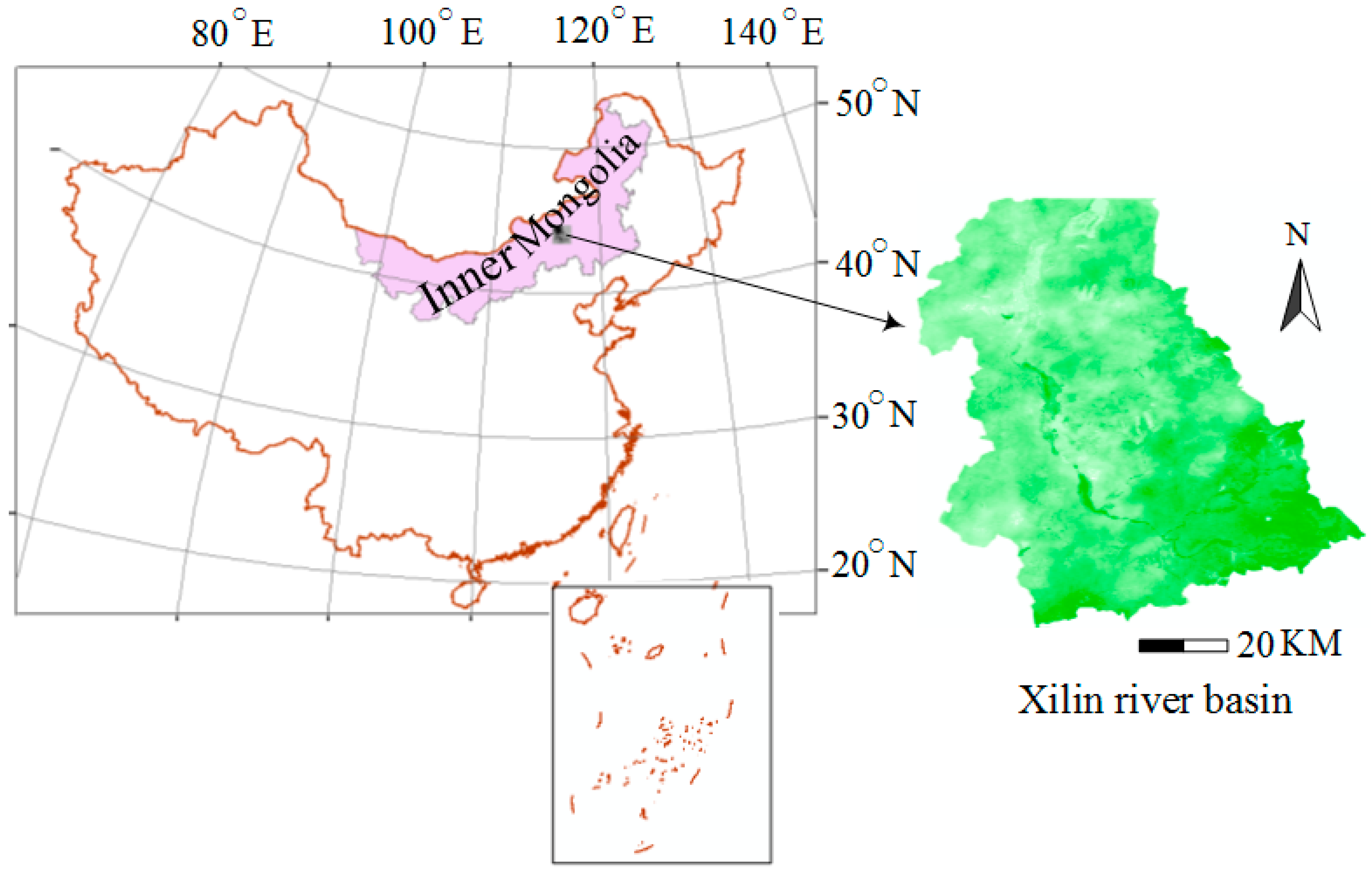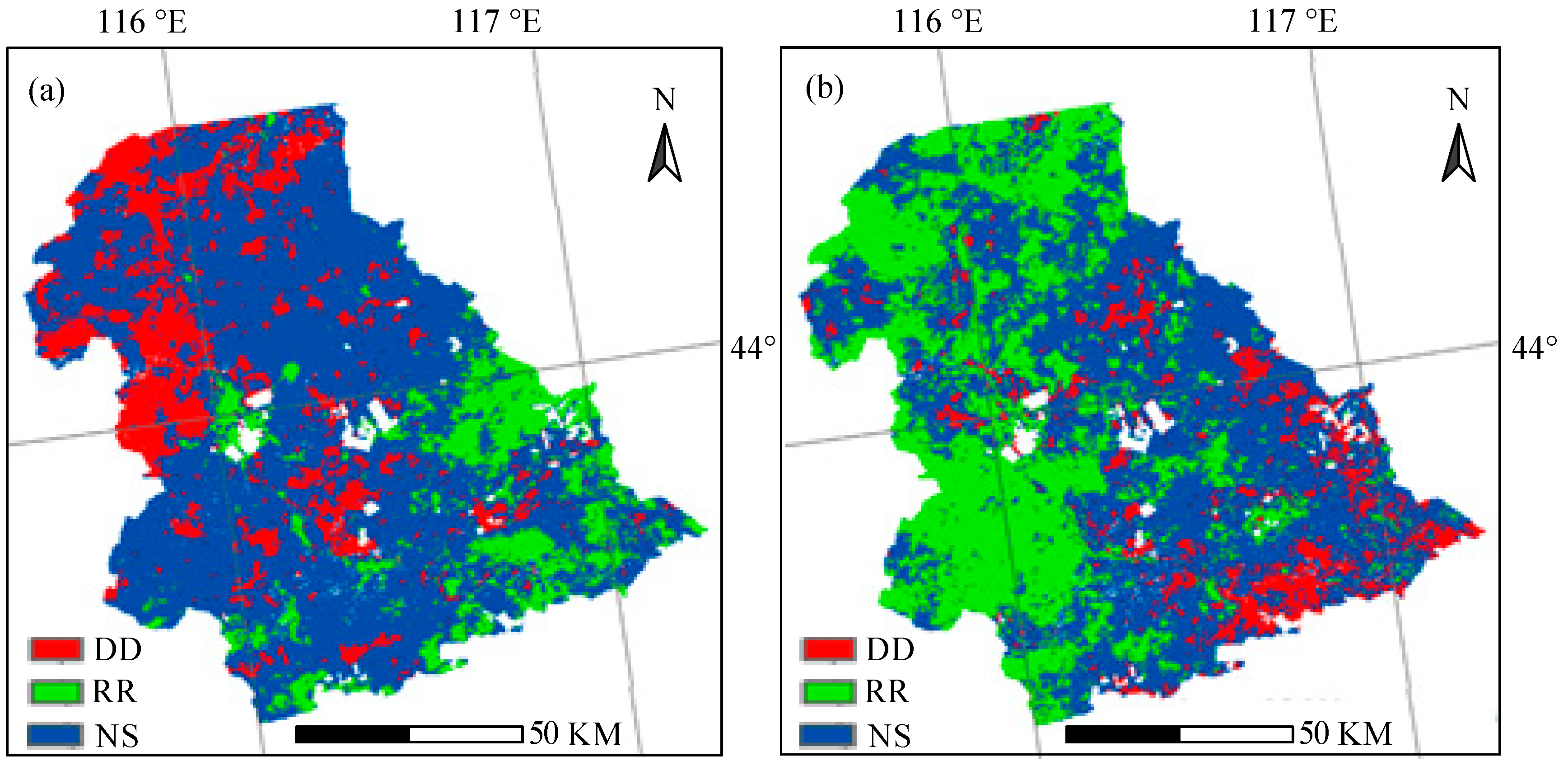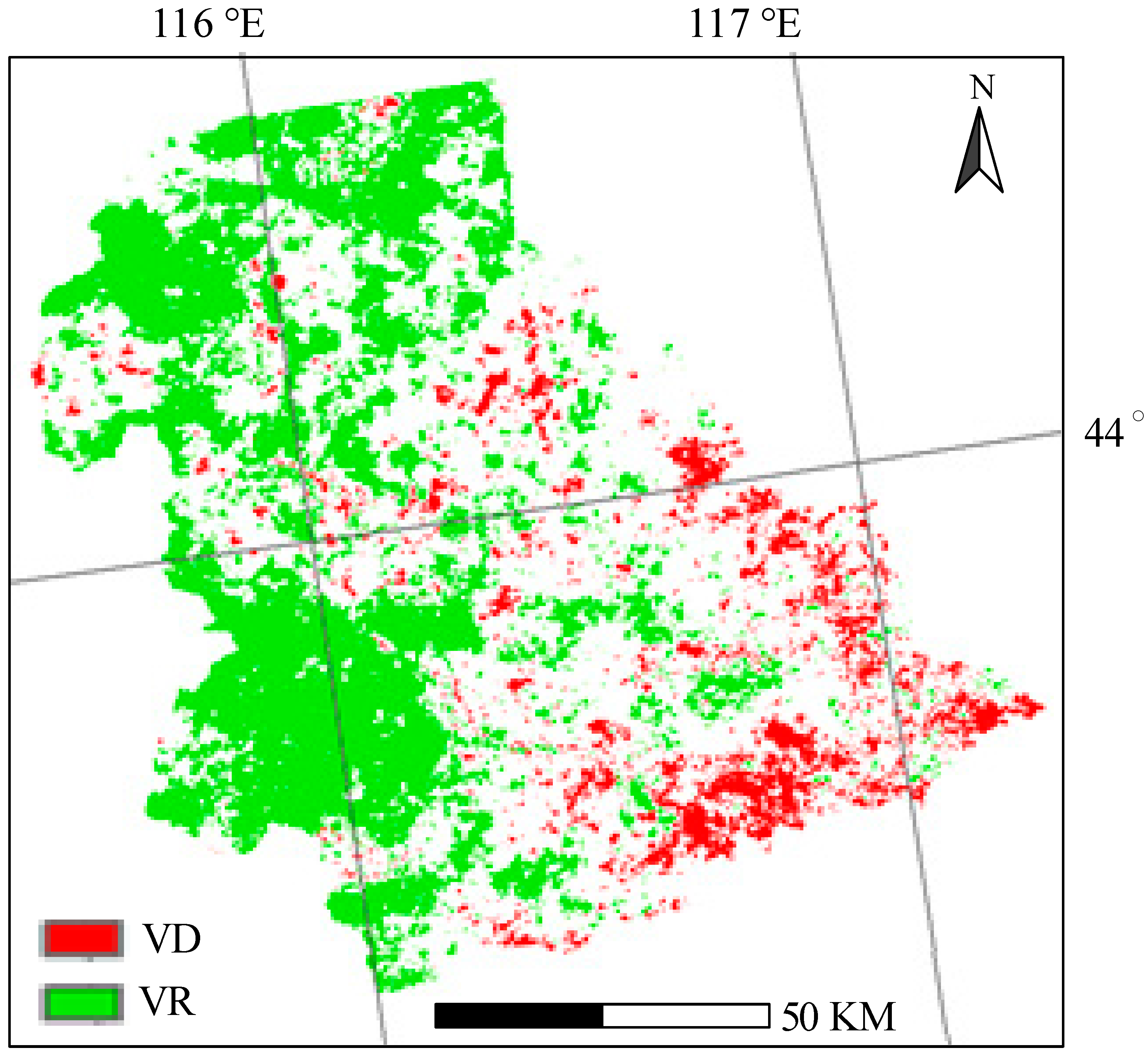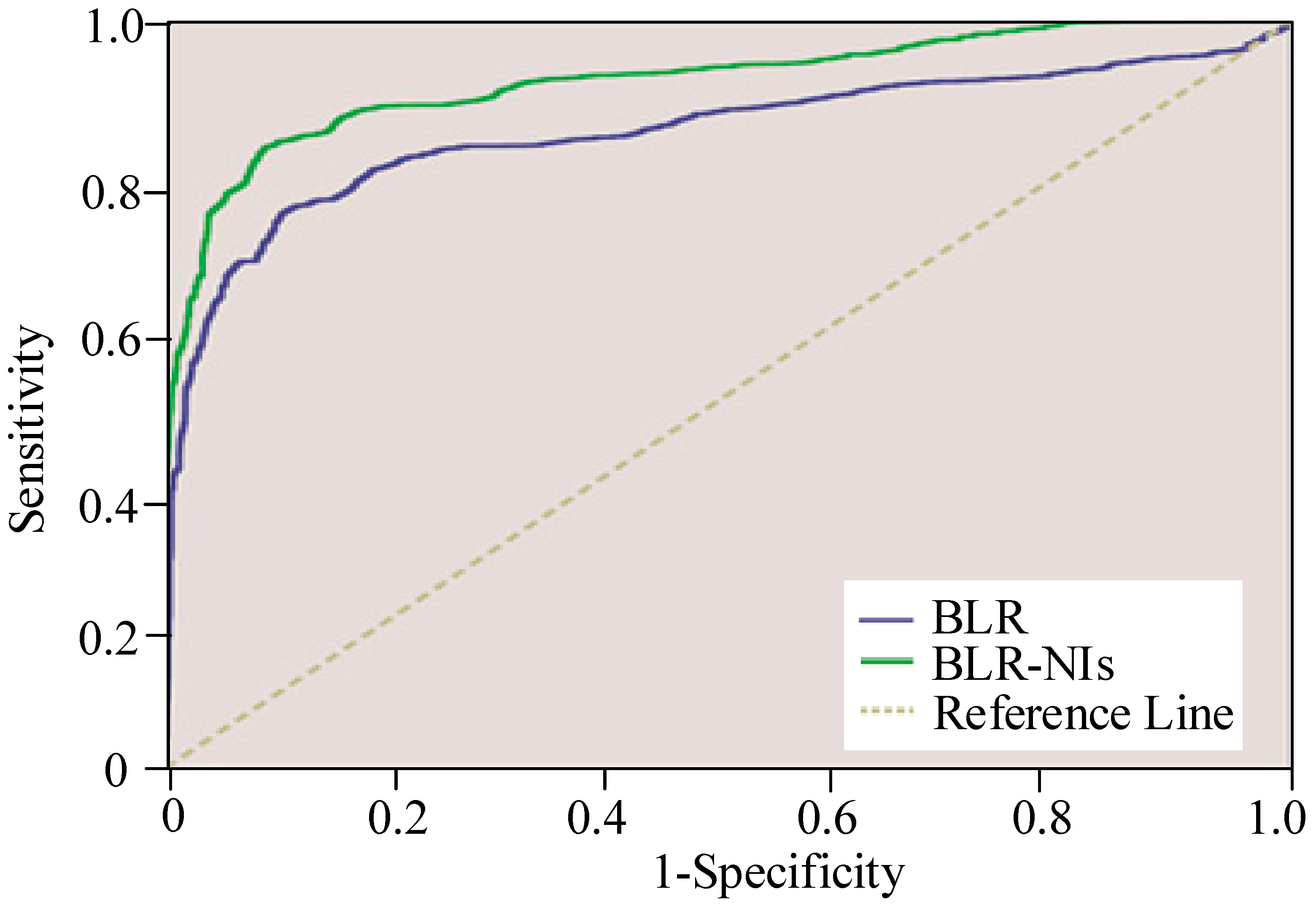Comparison of Modeling Grassland Degradation with and without Considering Localized Spatial Associations in Vegetation Changing Patterns
Abstract
:1. Introduction
2. Study Area, Data Sources and Methodology
2.1. Study Area
2.2. Data Sources
2.3. Methodology
3. Results
3.1. Spatio-Temporal Patterns in Vegetation Change
3.2. Comparison of Vegetation Degradation by the BLR Models
3.3. Accuracy Evaluation
4. Discussion
5. Conclusions
Acknowledgments
Author Contributions
Conflicts of Interest
Abbreviations
| GI | grazing intensity |
| RD | road density |
| OSM | open street map |
| IMAR | Inner Mongolia Autonomous Region |
| TP(s) | trajectory pattern(s) of grassland vegetation |
| NIs | neighborhood interaction(s) |
| RR | vegetation recovery during a particular period (e.g., T1 in this study) |
| DD | vegetation degradation during a particular period (e.g., T1 in this study) |
| NS | no significant change in vegetation during a particular period (e.g., T1 in this study) |
| F | a measurement for neighborhood interactions proposed in Verburg’s paper |
| FDD, FRR, FNS | F value computed for DD, RR and NS, respectively |
| BLR | binary logistic regression |
| BLR-NIs | binary logistic regression model with neighborhood interactions |
| NDVI | normalized difference vegetation index |
| RESTREND | residual trend analysis |
| RESTREND-NDVI | residual trend analysis based on NDVI |
| T1, T2 | two periods corresponding years 2000–2008 and 2007–2015, respectively |
| VD | redefined vegetation degradation based on the conversions matrix of TPs from T1 to T2 when RR or NS was observed in T1 and DD was observed in T2. Note that it is different from DD |
| VR | redefined vegetation restoration based on the conversions matrix of TPs from T1 to T2 when DD or NS was present in T1 and RR observed in T2. Note that it is different from RR |
| AUC | area under the curve |
| ROC | relative operating characteristic |
References
- Li, B. The rangeland degradation in North China and its preventive strategy. Sci. Agric. Sin. 1997, 30, 1–9. [Google Scholar] [CrossRef]
- Liu, J.; Yang, X.; Liu, H.L.; Qiao, Z. Algorithms and applications in grass growth monitoring. Abstr. Appl. Anal. 2013, 2013. [Google Scholar] [CrossRef]
- Ren, J.Z.; Hu, Z.Z.; Zhao, J.; Zhang, D.G.; Hou, F.J.; Lin, H.L.; Mu, X.D. A grassland classification system and its application in China. Rangel. J. 2008, 30, 199–209. [Google Scholar] [CrossRef]
- Ren, H.; Han, G.; Ohm, M.; Schönbach, P.; Gierus, M.; Taube, F. Do sheep grazing patterns affect ecosystem functioning in steppe grassland ecosystems in Inner Mongolia? Agric. Ecosyst. Environ. 2015, 213, 1–10. [Google Scholar] [CrossRef]
- Wang, T.; Xue, X.; Zhou, L.; Guo, J. Combating Aeolian Desertification in Northern China. Land Degrad. Dev. 2015, 26, 118–132. [Google Scholar] [CrossRef]
- Zhou, J.; Cai, W.; Qin, Y.; Lai, L.; Guan, T.; Zhang, X.; Jiang, L.; Du, H.; Yang, D.; Cong, Z.; et al. Alpine vegetation phenology dynamic over 16 years and its covariation with climate in a semi-arid region of China. Sci. Total Environ. 2016, 572, 119–128. [Google Scholar] [CrossRef] [PubMed]
- Wang, S.; Li, Y. Degradation mechanism of typical grassland in Inner Mongolia. Chin. J. Appl. Ecol. 1999, 10, 437–441. [Google Scholar] [CrossRef]
- Schönbach, P.; Wan, H.; Gierus, M.; Bai, Y.; Müller, K.; Lin, L.; Susenbeth, A.; Taube, F. Grassland responses to grazing: Effects of grazing intensity and management system in an Inner Mongolian steppe ecosystem. Plant Soil 2011, 340, 103–115. [Google Scholar] [CrossRef]
- Wagg, C.; Bender, S.F.; Widmer, F.; van der Heijden, M.G.A. Soil biodiversity and soil community composition determine ecosystem multifunctionality. Proc. Natl. Acad. Sci. USA 2014, 111, 5266–5270. [Google Scholar] [CrossRef] [PubMed]
- Veldman, J.W.; Buisson, E.; Durigan, G.; Fernandes, G.W.; Le Stradic, S.; Mahy, G.; Negreiros, D.; Overbeck, G.E.; Veldman, R.G.; Zaloumis, N.P.; et al. Toward an old-growth concept for grasslands, savannas, and woodlands. Front. Ecol. Environ. 2015, 13, 154–162. [Google Scholar] [CrossRef]
- Del Valle, H.F.; Elissalde, N.O.; Gagliardini, D.A.; Milovich, J. Status of desertification in the Patagonian region: Assessment and mapping from satellite imagery. Arid Soil Res. Rehabil. 1998, 12, 95–121. [Google Scholar] [CrossRef]
- Tong, C.; Yang, J.; Yong, W.; Yong, S. Spatial pattern of steppe degradation in Xilin River Basin of Inner Mongolia. J. Nat. Resour. 2002, 17, 571–578. [Google Scholar] [CrossRef]
- Tong, C.; Wu, J.; Yong, S.; Yang, J.; Yong, W. A landscape-scale assessment of steppe degradation in the Xilin River Basin, Inner Mongolia, China. J. Arid Environ. 2004, 59, 133–149. [Google Scholar] [CrossRef]
- Galdino, S.; Sano, E.E.; Andrade, R.G.; Grego, C.R.; Nogueira, S.F.; Bragantini, C.; Flosi, A.H.G. Large-scale Modeling of Soil Erosion with RUSLE for Conservationist Planning of Degraded Cultivated Brazilian Pastures. Land Degrad. Dev. 2016, 27, 773–784. [Google Scholar] [CrossRef]
- Xu, D.; Guo, X. Evaluating the impacts of nearly 30 years of conservation on grassland ecosystem using Landsat TM images. Grassl. Sci. 2015, 61, 227–242. [Google Scholar] [CrossRef]
- Li, S.; Verburg, P.H.; Lv, S.; Wu, J.; Li, X. Spatial analysis of the driving factors of grassland degradation under conditions of climate change and intensive use in Inner Mongolia, China. Reg. Environ. Chang. 2012, 12, 461–474. [Google Scholar] [CrossRef]
- Chen, B.; Zhang, X.; Tao, J.; Wu, J.; Wang, J.; Shi, P.; Zhang, Y.; Yu, C. The impact of climate change and anthropogenic activities on alpine grassland over the Qinghai-Tibet Plateau. Agric. For. Meteorol. 2014, 189–190, 11–18. [Google Scholar] [CrossRef]
- Xie, Y.; Sha, Z. Quantitative Analysis of Driving Factors of Grassland Degradation: A Case Study in Xilin River Basin, Inner Mongolia. Sci. World J. 2012, 2012. [Google Scholar] [CrossRef] [PubMed]
- Gang, C.; Zhou, W.; Chen, Y.; Wang, Z.; Sun, Z.; Li, J.; Qi, J.; Odeh, I. Quantitative assessment of the contributions of climate change and human activities on global grassland degradation. Environ. Earth Sci. 2014, 72, 4273–4282. [Google Scholar] [CrossRef]
- Deng, X.; Zhao, C.; Yan, H. Systematic modeling of impacts of land use and land cover changes on regional climate: A review. Adv. Meteorol. 2013, 2013. [Google Scholar] [CrossRef]
- Gao, J.G.; Zhang, Y.L.; Liu, L.S.; Wang, Z.F. Climate change as the major driver of alpine grasslands expansion and contraction: A case study in the Mt. Qomolangma (Everest) National Nature Preserve, southern Tibetan Plateau. Quat. Int. 2014, 336, 108–116. [Google Scholar] [CrossRef]
- Cao, Q.; Yu, D.; Georgescu, M.; Han, Z.; Wu, J. Impacts of land use and land cover change on regional climate: A case study in the agro-pastoral transitional zone of China. Environ. Res. Lett. 2015, 10, 124025. [Google Scholar] [CrossRef]
- Jiang, Y.; Bi, X.; Huang, J.; Bai, Y. Patterns and drivers of vegetation degradation in Xilin River Basin, Inner Mongolia, China. Chin. J. Plant Ecol. 2010, 34, 1132–1141. [Google Scholar] [CrossRef]
- Harris, R.B. Rangeland degradation on the Qinghai-Tibetan plateau: A review of the evidence of its magnitude and causes. J. Arid Environ. 2010, 74, 1–12. [Google Scholar] [CrossRef]
- Ford, H.; Garbutt, A.; Jones, D.L.; Jones, L. Impacts of grazing abandonment on ecosystem service provision: Coastal grassland as a model system. Agric. Ecosyst. Environ. 2012, 162, 108–115. [Google Scholar] [CrossRef]
- Qian, J.; Wang, Z.; Liu, Z.; Busso, C.A. Belowground Bud Bank Responses to Grazing Intensity in the Inner-Mongolia Steppe, China. Land Degrad. Dev. 2017, 28, 822–832. [Google Scholar] [CrossRef]
- Deng, X.; Huang, J.; Huang, Q.; Rozelle, S.; Gibson, J. Do roads lead to grassland degradation or restoration? A case study in Inner Mongolia, China. Environ. Dev. Econ. 2011, 16, 751–773. [Google Scholar] [CrossRef] [Green Version]
- Li, X.; Liu, Z.; Wang, Z.; Wu, X.; Li, X.; Hu, J.; Shi, H.; Guo, F.; Zhang, Y.; Hou, X. Pathways of Leymus chinensis individual aboveground biomass decline in natural semiarid grassland induced by overgrazing: A study at the plant functional trait scale. PLoS ONE 2015, 10. [Google Scholar] [CrossRef] [PubMed]
- Wang, Z.; Zhong, J.; Lan, H.; Wang, Z.; Sha, Z. Association analysis between spatiotemporal variation of net primary productivity and its driving factors in inner mongolia, china during 1994–2013. Ecol. Indic. 2017. [Google Scholar] [CrossRef]
- Lu, X.; Yan, Y.; Sun, J.; Zhang, X.; Chen, Y.; Wang, X.; Cheng, G. Short-term grazing exclusion has no impact on soil properties and nutrients of degraded alpine grassland in Tibet, China. Solid Earth 2015, 6, 1195–1205. [Google Scholar] [CrossRef]
- Li, A.; Wu, J.; Huang, J. Distinguishing between human-induced and climate-driven vegetation changes: A critical application of RESTREND in inner Mongolia. Landsc. Ecol. 2012, 27, 969–982. [Google Scholar] [CrossRef]
- Sha, Z.; Xie, Y.; Tan, X.; Bai, Y.; Li, J.; Liu, X. Assessing the impacts of human activities and climate variations on grassland productivity by partial least squares structural equation modeling (PLS-SEM). J. Arid Land 2017, 9, 473–488. [Google Scholar] [CrossRef]
- Evans, J.; Geerken, R. Discrimination between climate and human-induced dryland degradation. J. Arid Environ. 2004, 57, 535–554. [Google Scholar] [CrossRef]
- Wessels, K.J.; Prince, S.D.; Malherbe, J.; Small, J.; Frost, P.E.; VanZyl, D. Can human-induced land degradation be distinguished from the effects of rainfall variability? A case study in South Africa. J. Arid Environ. 2007, 68, 271–297. [Google Scholar] [CrossRef]
- Higginbottom, T.P.; Symeonakis, E. Assessing land degradation and desertification using vegetation index data: Current frameworks and future directions. Remote Sens. 2014, 6, 9552–9575. [Google Scholar] [CrossRef]
- Li, X.; Wang, H.; Zhou, S.; Sun, B.; Gao, Z. Did ecological engineering projects have a significant effect on large-scale vegetation restoration in Beijing-Tianjin Sand Source Region, China? A remote sensing approach. Chin. Geogr. Sci. 2016, 26, 216–228. [Google Scholar] [CrossRef]
- Tong, X.; Wang, K.; Yue, Y.; Brandt, M.; Liu, B.; Zhang, C.; Liao, C.; Fensholt, R. Quantifying the effectiveness of ecological restoration projects on long-term vegetation dynamics in the karst regions of Southwest China. Int. J. Appl. Earth Obs. Geoinf. 2017, 54, 105–113. [Google Scholar] [CrossRef]
- Chytrý, M.; Wild, J.; Pyšek, P.; Jarošík, V.; Dendoncker, N.; Reginster, I.; Pino, J.; Maskell, L.C.; Vilà, M.; Pergl, J.; et al. Projecting trends in plant invasions in Europe under different scenarios of future land-use change. Glob. Ecol. Biogeogr. 2012, 21, 75–87. [Google Scholar] [CrossRef] [Green Version]
- Du, S.; Wang, Q.; Guo, L. Spatially varying relationships between land-cover change and driving factors at multiple sampling scales. J. Environ. Manag. 2014, 137, 101–110. [Google Scholar] [CrossRef] [PubMed]
- Selwood, K.E.; Mcgeoch, M.A.; Mac Nally, R. The effects of climate change and land-use change on demographic rates and population viability. Biol. Rev. 2015, 90, 837–853. [Google Scholar] [CrossRef] [PubMed]
- Mas, J.F.; Kolb, M.; Paegelow, M.; Camacho Olmedo, M.T.; Houet, T. Inductive pattern-based land use/cover change models: A comparison of four software packages. Environ. Model. Softw. 2014, 51, 94–111. [Google Scholar] [CrossRef] [Green Version]
- Anputhas, M.; Janmaat, J.J.A.; Nichol, C.F.; Wei, X. (Adam) Modelling spatial association in pattern based land use simulation models. J. Environ. Manag. 2016, 181, 465–476. [Google Scholar] [CrossRef] [PubMed]
- Guo, L.; Du, S.; Haining, R.; Zhang, L. Global and local indicators of spatial association between points and polygons: A study of land use change. Int. J. Appl. Earth Obs. Geoinf. 2012, 21, 384–396. [Google Scholar] [CrossRef]
- He, C.; Zhang, Q.; Li, Y.; Li, X.; Shi, P. Zoning grassland protection area using remote sensing and cellular automata modeling—A case study in Xilingol steppe grassland in northern China. J. Arid Environ. 2005, 63, 814–826. [Google Scholar] [CrossRef]
- Haining, R.P. Spatial Data Analysis in the Social and Environmental Sciences; Cambridge University Press: Cambridge, UK, 1990. [Google Scholar]
- Verburg, P.H.; de Nijs, T.C.M.; van Eck, J.R.; Visser, H.; de Jong, K. A method to analyse neighbourhood characteristics of land use patterns. Comput. Environ. Urban Syst. 2004, 28, 667–690. [Google Scholar] [CrossRef]
- Kawamura, K.; Akiyama, T.; Yokota, H.O.; Tsutsumi, M.; Yasuda, T.; Watanabe, O.; Wang, S. Quantifying grazing intensities using geographic information systems and satellite remote sensing in the Xilingol steppe region, Inner Mongolia, China. Agric. Ecosyst. Environ. 2005, 107, 83–93. [Google Scholar] [CrossRef]
- Zhang, X.; Niu, J.; Buyantuev, A.; Zhang, Q.; Dong, J.; Kang, S.; Zhang, J. Understanding grassland degradation and restoration from the perspective of ecosystem services: A case study of the Xilin River Basin in Inner Mongolia, China. Sustainability 2016, 8, 594. [Google Scholar] [CrossRef]
- Zhang, X.; Niu, J.; Zhang, Q.; Dong, J.; Zhang, J. Soil conservation function and its spatial distribution of grassland ecosystems in Xilin River Basin, Inner Mongolia. Acta Pratac. Sin. 2015, 24, 12–20. [Google Scholar] [CrossRef]
- Chen, S.; Bai, Y.; Zhang, L.; Han, X. Comparing physiological responses of two dominant grass species to nitrogen addition in Xilin River Basin of China. Environ. Exp. Bot. 2005, 53, 65–75. [Google Scholar] [CrossRef]
- Li, L.; Chen, Z.; Wang, Q.; Liu, X.; Li, Y. Changes in soil carbon storage due to over-grazing in Leymus chinensis steppe in the Xilin River Basin of Inner Mongolia. J. Environ. Sci. 1997, 9, 486–490. [Google Scholar]
- Geerken, R.; Ilaiwi, M. Assessment of rangeland degradation and development of a strategy for rehabilitation. Remote Sens. Environ. 2004, 90, 490–504. [Google Scholar] [CrossRef]
- Swets, J. Measuring the accuracy of diagnostic systems. Science 1988, 240, 1285–1293. [Google Scholar] [CrossRef] [PubMed]
- Manel, S.; Williams, H.C.; Ormerod, S.J. Evaluating presence absence models in ecology; the need to count for prevalence. J. Appl. Ecol. 2001, 38, 921–931. [Google Scholar] [CrossRef]
- Sun, L.; Yang, L.; Hao, L.; Fang, D.; Jin, K.; Huang, X. Hydrological effects of vegetation cover degradation and environmental implications in a semiarid temperate Steppe, China. Sustainability 2017, 9, 281. [Google Scholar] [CrossRef]
- Liu, Y.Y.; Evans, J.P.; McCabe, M.F.; de Jeu, R.A.M.; van Dijk, A.I.J.M.; Dolman, A.J.; Saizen, I. Changing Climate and Overgrazing Are Decimating Mongolian Steppes. PLoS ONE 2013, 8. [Google Scholar] [CrossRef] [PubMed]
- Keshkamat, S.S.; Tsendbazar, N.E.; Zuidgeest, M.H.P.; Shiirev-Adiya, S.; van der Veen, A.; van Maarseveen, M.F.A.M. Understanding transportation-caused rangeland damage in Mongolia. J. Environ. Manag. 2013, 114, 433–444. [Google Scholar] [CrossRef] [PubMed]
- Li, X.B.; Li, R.H.; Li, G.Q.; Wang, H.; Li, Z.F.; Li, X.; Hou, X.Y. Human-induced vegetation degradation and response of soil nitrogen storage in typical steppes in Inner Mongolia, China. J. Arid Environ. 2016, 124, 80–90. [Google Scholar] [CrossRef]
- Jacobs-Crisioni, C.; Rietveld, P.; Koomen, E. The impact of spatial aggregation on urban development analyses. Appl. Geogr. 2014, 47, 46–56. [Google Scholar] [CrossRef]




| Model | Variable | β | Exp(β) | 95% CI for Exp(β) | |
|---|---|---|---|---|---|
| Lower | Upper | ||||
| BLR | GI | 0.610 | 1.841 | 1.554 | 2.180 |
| RD | 1.847 | 6.339 | 5.634 | 7.133 | |
| Const. | 0.417 | 1.518 | |||
| BLR-NIs | #GI | ||||
| RD | 1.671 | 5.318 | 4.673 | 6.052 | |
| FDD | −0.749 | 0.473 | 0.413 | 0.541 | |
| FRR | 2.176 | 8.812 | 6.820 | 11.387 | |
| #FNS | |||||
| Const. | 0.832 | 2.299 | |||
| Model | Data from | Response | Predicted | Percentage Corr. | |
|---|---|---|---|---|---|
| VD | Non-VD | ||||
| BLR | Observed | VD | 1701 | 799 | 68.0% |
| Non-VD | 205 | 2295 | 91.8% | ||
| Overall acc. | 79.9% | ||||
| BLR-NIs | Observed | VD | 1940 | 560 | 77.6% |
| Non-VD | 163 | 2337 | 93.5% | ||
| Overall acc. | 85.5% | ||||
| Model | Cox & Snell R2 | Nagelkerke R2 | AUC |
|---|---|---|---|
| BLR | 0.368 | 0.490 | 0.850 |
| BLR-NIs | 0.499 | 0.665 | 0.919 |
© 2018 by the authors. Licensee MDPI, Basel, Switzerland. This article is an open access article distributed under the terms and conditions of the Creative Commons Attribution (CC BY) license (http://creativecommons.org/licenses/by/4.0/).
Share and Cite
Wang, Y.; Wang, Z.; Li, R.; Meng, X.; Ju, X.; Zhao, Y.; Sha, Z. Comparison of Modeling Grassland Degradation with and without Considering Localized Spatial Associations in Vegetation Changing Patterns. Sustainability 2018, 10, 316. https://doi.org/10.3390/su10020316
Wang Y, Wang Z, Li R, Meng X, Ju X, Zhao Y, Sha Z. Comparison of Modeling Grassland Degradation with and without Considering Localized Spatial Associations in Vegetation Changing Patterns. Sustainability. 2018; 10(2):316. https://doi.org/10.3390/su10020316
Chicago/Turabian StyleWang, Yuwei, Zhenyu Wang, Ruren Li, Xiaoliang Meng, Xingjun Ju, Yuguo Zhao, and Zongyao Sha. 2018. "Comparison of Modeling Grassland Degradation with and without Considering Localized Spatial Associations in Vegetation Changing Patterns" Sustainability 10, no. 2: 316. https://doi.org/10.3390/su10020316





